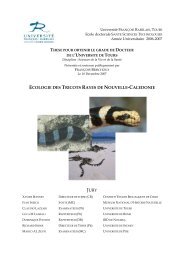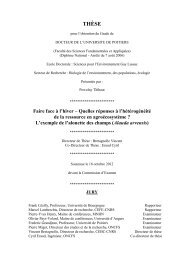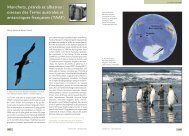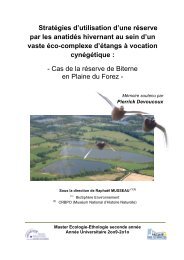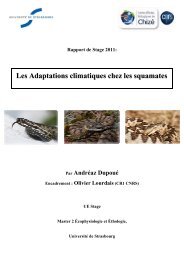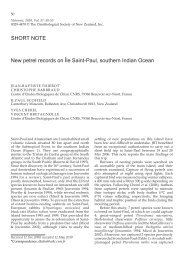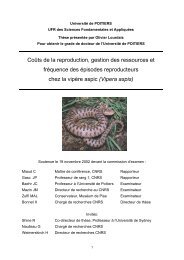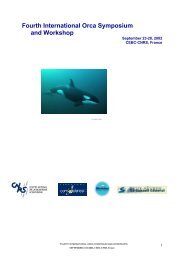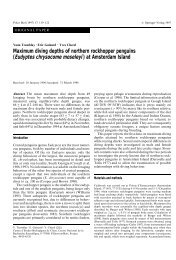Forçage environnemental et prédateurs marins ... - Cebc - CNRS
Forçage environnemental et prédateurs marins ... - Cebc - CNRS
Forçage environnemental et prédateurs marins ... - Cebc - CNRS
Create successful ePaper yourself
Turn your PDF publications into a flip-book with our unique Google optimized e-Paper software.
elation positive entre les températures de surface <strong>et</strong> le succès reproducteur chez deux espèces piscivores<br />
(le starique cristatelle A<strong>et</strong>hia cristatella <strong>et</strong> le starique perroqu<strong>et</strong> Cyclorhinchus psittacula) mais négative chez<br />
deux espèces planctonivores (le macareux huppé Lunda cirrhata <strong>et</strong> le macareux cornu Fratercula<br />
corniculata) en mer d’Okhotsk. Dans l’Océan Austral, le niveau trophique des espèces pour lesquelles des<br />
relations entre variables climatiques <strong>et</strong> paramètres démographiques ont été détectées est très large<br />
(Tableau 5), allant d’espèces planctonivores (baleine franche australe) à des espèces se nourrissant<br />
principalement de calamars. Ceci suggère des eff<strong>et</strong>s potentiels du climat quel que soit le niveau trophique<br />
des <strong>prédateurs</strong> <strong>marins</strong> endothermes de l’Océan Austral. Néanmoins, lorsque l’on se focalise sur les trois<br />
paramètres démographiques les plus étudiés (succès reproducteur, survie adulte <strong>et</strong> nombre de<br />
reproducteurs) il semble exister une tendance vers un impact moins fréquent des variables climatiques sur<br />
ces paramètres chez les espèces occupant des niveaux trophiques élevés (Figure 28 Adultes, données<br />
issues du tableau 4).<br />
Tableau 4. Espèces d’oiseaux <strong>et</strong> de mammifères <strong>marins</strong> de l’Océan Austral pour lesquelles des relations<br />
entre paramètres démographiques <strong>et</strong> variables climatiques ont été misent en évidence <strong>et</strong> dont le niveau<br />
trophique a été mesuré par une même méthode isotopique. δ 15 N (‰) indique le niveau trophique (Hobson <strong>et</strong><br />
al. 1994). Des valeurs faibles (fortes) indiquent un niveau trophique bas (haut).<br />
Espèce Statut δδδδ 15 N (‰) SD δδδδ 15 N (‰) Référence<br />
Prion de Belcher adulte 8.5 0.7 Cherel <strong>et</strong> al. (2002a)<br />
Manchot adélie adulte 9 0.2 Cherel (2008)<br />
Pétrel bleu adulte 9.1 0.6 Cherel <strong>et</strong> al. (2002b)<br />
Manchot royal adulte 9.8 0.2 Cherel <strong>et</strong> al. (2008)<br />
Pétrel des neiges adulte 9.9 1.4 Hodum <strong>et</strong> Hobson (2000)<br />
Manchot papou adulte 10.4 1.3 Cherel <strong>et</strong> al. (2008)<br />
Fulmar antarctique adulte 10.5 0.6 Hodum <strong>et</strong> Hobson (2000)<br />
Albatros fuligineux à dos clair adulte 11.86 1.92 Cherel <strong>et</strong> al. non publié<br />
Manchot empereur adulte 12 0.4 Cherel (2008)<br />
Albatros fuligineux à dos sombre adulte 14.48 0.5 Cherel <strong>et</strong> al. non publié<br />
Albatros à bec jaune adulte 15.36 0.9 Cherel <strong>et</strong> al. non publié<br />
Albatros à sourcils noirs adulte 15.37 1.76 Cherel <strong>et</strong> al. non publié<br />
Albatros hurleur adulte 15.67 0.75 Cherel <strong>et</strong> al. non publié<br />
Albatros à sourcils noirs adulte 15.79 0.58 Cherel <strong>et</strong> al. (2000)<br />
Pétrel à menton blanc adulte 16.65 0.47 Cherel <strong>et</strong> al. non publié<br />
Albatros d'Amsterdam adulte 16.89 0.35 Cherel <strong>et</strong> al. non publié<br />
Prion de Belcher poussin 8.9 0.5 Cherel <strong>et</strong> al. (2002a)<br />
Pétrel bleu poussin 9.7 0.8 Cherel <strong>et</strong> al. (2002b)<br />
Manchot adélie poussin 10.2 0.8 Cherel (2008)<br />
Fulmar antarctique poussin 11.2 1.1 Hodum <strong>et</strong> Hobson (2000)<br />
Fulmar géant poussin 11.97 0.23 Cherel <strong>et</strong> al. non publié<br />
Pétrel des neiges poussin 12 0.4 Hodum <strong>et</strong> Hobson (2000)<br />
Pétrel à menton blanc poussin 12.21 0.69 Cherel <strong>et</strong> al. non publié<br />
Fulmar de Hall poussin 12.35 0.19 Cherel <strong>et</strong> al. non publié<br />
Albatros fuligineux à dos clair poussin 12.37 0.42 Cherel <strong>et</strong> al. non publié<br />
Manchot empereur poussin 12.4 0.7 Cherel (2008)<br />
Albatros à sourcils noirs poussin 12.63 0.7 Cherel <strong>et</strong> al. non publié<br />
Albatros à sourcils noirs poussin 12.88 0.53 Cherel <strong>et</strong> al. non publié<br />
Albatros fuligineux à dos sombre poussin 13.09 0.45 Cherel <strong>et</strong> al. non publié<br />
Pétrel gris poussin 13.62 0.44 Cherel <strong>et</strong> al. non publié<br />
Albatros hurleur poussin 13.89 0.35 Cherel <strong>et</strong> al. non publié<br />
Albatros à bec jaune poussin 14.12 0.43 Cherel <strong>et</strong> al. non publié<br />
Albatros d’Amsterdam poussin 15.69 0.34 Cherel <strong>et</strong> al. non publié<br />
61



